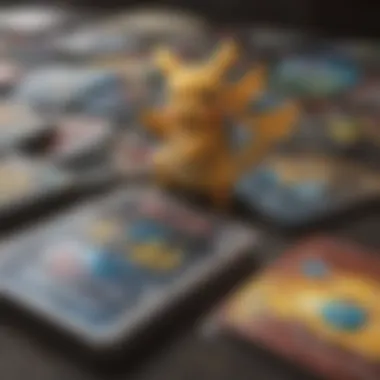Exploring Gen 1 Pokémon Cards: A Comprehensive Guide


Intro
Generation One Pokémon cards represent a significant chapter in the history of trading cards and pop culture. Released primarily in the late 1990s, these cards were part of a larger phenomenon that combined a video game, a TV series, and an expansive toy line. As Pokémon gained popularity worldwide, so too did interest in its collectible cards. The appeal lies not just in the game mechanics or the art but also in the nostalgia tied to childhood memories of trading with friends.
In this guide, we will examine various aspects of these cards. We will explore their origins, design features, rarity, and how their value has evolved over the years. Moreover, we'll discuss their ongoing relevance in both the collector's market and modern gaming culture. This article serves as a comprehensive resource for collectors, enthusiasts, and newcomers looking to understand the landscape of Gen 1 Pokémon cards better.
The aim is to provide an in-depth perspective on these cards, shining a light on why they remain beloved by many and how they continue to form connections across generations.
Preamble to Gen Pokémon Cards
The world of Pokémon cards offers a fascinating glimpse into a unique intersection of nostalgia, strategy, and commerce. The Generation One (Gen 1) Pokémon cards, released in the late 1990s, stand as a pivotal chapter in trading card history. These cards introduced Pokémon to a global audience and set the foundation for future trading card games.
Understanding Gen 1 Pok�émon cards is essential for several reasons. First, they hold intrinsic value not only for collectors but also for those interested in gaming history. The designs, characters, and gameplay imbued in these cards have made them iconic.
Second, Gen 1 cards shaped the trading card game landscape, influencing how future games were developed, marketed, and consumed. Their popularity catalyzed phenomena like tournaments and large-scale competitive play, which continue to thrive today. Collectors find significance here, as the strategy and community foster an environment that intertwines play with investment.
Lastly, exploring these cards provides insights into cultural trends and consumer behaviors of the time. As the Pokémon franchise expanded, so did the diversity in card designs and mechanics, echoing societal shifts in gaming and entertainment. In this article, we will delve deeper into the historical context and impact of Gen 1 cards, as well as the intricate details that define their significance today.
Historical Context
The narrative of Gen 1 Pokémon cards traces back to 1996, when The Pokémon Company launched its first set in Japan. These cards accompanied the popular Pokémon video games, creating a complementary marketing strategy. They quickly gained traction due to the popularity of the Pokémon anime series, leading to widespread adoption across North America and other regions.
By 1999, Pokémon cards had dominated the trading card market, overtaking major players such as Magic: The Gathering. Their appeal was not limited to children; adults also found value in collecting, trading, and participating in tournaments. This cross-generational engagement solidified Gen 1's status within the gaming and collectible cultures.
Impact on Trading Card Games
The emergence of Gen 1 Pokémon cards revolutionized the trading card game ecosystem. Before their arrival, most trading cards were often standalone products with limited interaction between collectors and players. However, the Pokémon Trading Card Game introduced a dynamic approach where strategy, deck building, and competitive play became fundamental aspects.
Moreover, the wide range of cards involving various Pokémon types and rarity levels invited new players into the hobby. The simple mechanics paired with rich lore made it engaging for newcomers while providing depth for seasoned players. Communities formed around these cards, leading to organized playgroups, tournaments, and events, amplifying their societal relevance.
The commercial success of Gen 1 cards also led to the development of merchandise, collectibles, and expansions, creating a blueprint for future trading card games. As trends evolved, so did Pokémon cards, maintaining a significant presence in the gaming market. This legacy is crucial, as it reflects the adaptability of the franchise and its enduring appeal to enthusiasts worldwide.
The Creation of Pokémon Cards
The genesis of Pokémon cards is a pivotal moment not only in the world of trading cards but also in the broader landscape of gaming culture. Understanding the careful design and collaborations behind these cards provides context to their significance and lasting impact. This section will explore the collaborative efforts that led to the creation of these cards and delve into the initial release that captivated audiences.
Collaboration with Creators
The creation of Pokémon cards can be traced back to a collaboration among multiple entities, each bringing their own expertise and vision. The Pokémon Company, along with designers from Game Freak and Creatures Inc., took a unique approach in combining gameplay mechanics with collectible elements.
Key figures such as Satoshi Tajiri and Ken Sugimori played essential roles. Tajiri's idea of catching creatures resonated with many, while Sugimori’s artistic talent helped shape the visual style of Pokémon. This cooperation resulted in cards that not only serve as game components but also as artwork to be appreciated and collected.
Market research played a also crucial role during the development phase. Feedback from focus groups influenced the design and card types, ensuring they would appeal to both players and collectors. Overall, the synergy among the creators was instrumental in crafting a product that could transcend traditional gaming and become a collectible phenomenon.
Initial Release Information
The first Pokémon cards made their debut in Japan in 1996 as part of the Pokémon Trading Card Game. Initial enthusiasm quickly translated into widespread popularity. Pokémón started with a limited set that featured 102 cards, consisting of various types including Grass, Fire, Water, and more. The artworks were vibrant and distinct, drawing attention to the characters.
Upon release, the cards were packaged in booster packs, allowing players to expand their collections. The marketing strategy was well-planned and effective. Commercials showcased players battling with their Pokémon, engaging viewers and encouraging them to join in the fun.
"The initial release was not just about cards; it was a cultural event that ignited a passion that continues today."
The North American version followed in 1999, broadening the audience further. With this, the trading card game saw an explosion of popularity. In the years to come, expansion sets would evolve, introducing new mechanics and increasing the card pool significantly. The initial release set the standard for the trading card game and has led to numerous expansions and iterations over the decades.
The creation phase of Pokémon cards is integral to understanding their impact and how they laid the groundwork for the enduring legacy of the franchise in both gaming and collectibles.
Types of Gen Pokémon Cards


Understanding the various types of Generation One Pokémon cards is essential for collectors and enthusiasts alike. Each category plays a distinct role in the dynamics of collection, trading, and valuation. In this section, we will explore the differences between common, uncommon, and rare cards, the distinctions between holographic and non-holographic variants, and the significance of promotional cards in the Gen 1 series.
Common, Uncommon, and Rare Cards
In the realm of Pokémon cards, the classification into common, uncommon, and rare is foundational. Common cards are typically the most abundant, often found in packs and accessible to new players. They introduce basic gameplay mechanics and encourage engagement with the card game.
Uncommon cards strike a balance between availability and desirability. These cards usually showcase more distinctive abilities or artwork, making them more appealing to both players and collectors.
Rare cards hold a special place in the hearts of Pokémon enthusiasts. These cards are not merely scarce; they often embody iconic characters or special features that enhance their appeal. The allure of rare cards motivates many collectors to seek out the limited releases from the original sets.
Collectors often find it challenging to differentiate between these categories due to production nuances.
Key Points:
- Common Cards: Widely available and foundational for gameplay.
- Uncommon Cards: More appealing, balanced between availability and desirability.
- Rare Cards: Highly sought after, often featuring iconic characters or abilities.
Holographic vs. Non-Holographic Cards
Holographic cards represent a visual and collectible milestone in the Pokémon card world. These cards feature a distinctive shiny foil that catches the eye, enhancing their attractiveness. Holographic cards often include prominent Pokémon or are tied to significant sets, making them a cornerstone for any collection.
Conversely, non-holographic cards serve practical purposes in gameplay. They contribute to deck-building strategies and often feature essential Pokémon essential for live battles. While they may lack the visual flair of their holographic counterparts, non-holographic cards are vital in competitive gaming.
This distinction impacts how collectors view each type. Holographic cards often fetch higher prices on the market, driven by their visual appeal and relative rarity. In contrast, non-holographic cards might be undervalued but are critical for serious collectors focusing on gameplay.
Promo Cards and Their Significance
Promo cards, or promotional cards, were released to enhance visibility and excitement surrounding Pokémon. These cards are not part of the standard sets and often feature unique artwork or abilities. They are typically released in conjunction with special events, games, or product launches, elevating their uniqueness.
The significance of promo cards goes beyond mere collection. They symbolize the dynamic relationship between Pokémon and its community, often becoming conversation starters among collectors. Their scarcity makes them highly coveted. Some promo cards even have higher market values than traditional rare cards, demonstrating their broad appeal.
In summary, understanding the types of Gen 1 Pokémon cards is crucial for navigating the collecting landscape. Each card type serves a purpose, and knowing their significance helps collectors make informed decisions.
Design Features of Gen Cards
The design of Generation One Pokémon cards plays a crucial role not only in their aesthetic appeal but also in their functionality and collectability. Understanding these design features provides deeper insights into the cards’ historical significance and their enduring popularity among collectors and enthusiasts alike. Each element of the card, from artwork to layout, contributes to the overall experience and perception of these iconic collectibles.
Artwork and Illustrations
The artwork on Gen 1 Pokémon cards is a defining characteristic that distinguishes them in the trading card game landscape. Each illustration captures the essence of the Pokémon, often showcasing unique poses and vibrant colors that resonate with the creature's attributes. Artists like Ken Sugimori have played an essential part in creating memorable representations, staying true to the characters from the anime and video games.
The style of the illustrations ranges from whimsical to fierce, allowing for a diverse representation of the Pokémon universe. Collectors often seek cards not just for their rarity but also for the artwork itself. Iconic cards, such as the Charizard holographic, are especially coveted for their artistry. This attraction can sometimes overshadow the card's gameplay value, as many individuals prioritize visual appeal in their collections.
Additionally, the distinct style of these artworks evokes nostalgia for many fans who grew up with the franchise. This emotional connection amplifies the cultural significance of Gen 1 cards, making them more than just game pieces but symbols of a cherished childhood experience.
Card Layout and Text
The layout of Gen 1 Pokémon cards is designed for clarity and functionality, ensuring players can easily grasp vital information during gameplay. Each card includes essential components such as the Pokémon's name, type, HP, and moves, positioned in a logical and readable manner. The use of different fonts and colors helps differentiate between various categories, enhancing the ease of understanding.
Furthermore, the text on the cards serves a dual purpose. It provides gameplay mechanics, such as attack details and special abilities, while also delivering flavor text that adds depth to the Pokémon's lore. This integration of gameplay with narrative enriches the collecting experience, appealing to both competitive players and casual collectors.
This careful consideration of layout ensures that even when cards are viewed en masse, important details remain discernible, which is particularly valuable during tournaments or casual play.
The card design also reflects the era of its creation, with a simple yet effective aesthetic that echoes the early days of trading card games. Simplicity in design allows the artwork to shine while keeping player experience at the forefront. This combination showcases the thoughtful approach taken in crafting Gen 1 Pokémon cards, contributing to their lasting legacy in card collecting and gaming.
The Rarity and Collectability of Gen Cards
The rarity and collectability of Generation One Pokémon cards shape their significance within the trading card community. Understanding these aspects is essential for collectors and fans alike. Rarity often dictates demand, and alongside this, the collectible nature of these cards creates a complex market where values can fluctuate significantly. Thus, familiarity with rarity is not just beneficial, it is foundational for anyone engaging in this hobby.
Factors Influencing Rarity


Several factors contribute to the rarity of Gen 1 Pokémon cards. One primary element is the print run, which refers to the number of cards produced. Cards released in smaller quantities naturally become more valuable over time. For instance, certain holographic cards from the original set have become highly sought after. Other influencing factors include:
- Card Condition: Cards in near-mint or mint condition are rarer than those that have seen wear and tear. Grading services evaluate the quality, impacting their collectability.
- Popularity of Pokémon: Some Pokémon gain a following over others, leading to more interest in specific cards. Iconic Pokémon like Charizard tend to command higher prices due to their fame.
- Event Promos: Cards released during special events or tournaments can also be rare, as they were not widely distributed. These promotions can increase a card’s desirability.
Market Trends Over the Years
The market for Gen 1 Pokémon cards has experienced various trends since their release in the late 1990s. Initially, these cards were commonly traded among friends, presenting low-value markets filled with enthusiasm. As time passed, a noticeable shift occurred. The rise of online platforms has allowed collectors to connect globally, which intensified interest.
In recent years, we have seen a resurgence in collecting, partly fueled by nostalgia. Many adults who grew up with Pokémon are now re-entering the market with greater financial capability. Additionally, many public sales and auctions of rare cards have led to substantial price increases, often reaching thousands of dollars for limited editions. Collectors are no longer merely enthusiasts; they are participating in a budding investment market, representing not just childhood memories but also potential profit.
"The market for Gen 1 Pokémon cards has significantly evolved, and understanding its dynamics is crucial for serious collectors."
Consequently, each generation of collectors plays a role in shaping market trends, thus reinforcing the idea that rarity goes beyond mere numbers; it encompasses community dynamics and shared passions.
Understanding these factors paired with attention to market trends can greatly enhance one's ability to navigate the trading card landscape effectively.
The Value of Gen Pokémon Cards
Understanding the value of Generation One Pokémon cards is crucial for collectors and enthusiasts alike. These cards are not just mere collectibles; they represent a unique blend of nostalgia, artistry, and a booming market within the trading card world. The demand for these items has seen significant fluctuations over the years, and many collectors view them as an investment opportunity. This section explores the current market values, the various factors that influence card values, and the potential for investment returns.
Current Market Values
The market for Gen 1 Pokémon cards has evolved dramatically since their original launch in the late 1990s. Card values can range from a few dollars to several thousands, depending on their rarity, condition, and demand. As of today, some of the most sought-after cards, like the Charizard holographic card, can fetch prices well over fifty thousand dollars in mint condition. More common cards generally hold lower values, often finding buyers in the range of five to twenty dollars.
Prices are not static; they can fluctuate based on market trends. For instance, during peak interest periods, such as anniversaries or nostalgic moments in pop culture, card values might spike. According to recent reports, the popularity of Pokémon due to new game releases or remakes also stimulates market interest.
Factors Affecting Card Value
Several factors determine the monetary value of Gen 1 Pokémon cards. Understanding these can help collectors make informed decisions.
- Rarity: Cards that are produced in smaller quantities are generally more valuable. For example, cards like the Pikachu Illustrator are considered extremely rare and fetch sky-high prices.
- Condition: The state of a card is paramount. Cards graded by professional services (such as PSA or BECKETT) possess more value. A mint condition card is worth significantly more than one with visible wear and tear.
- Market Demand: If a particular card is in high demand among collectors, its value can increase. Trends in the collector community play a large role in value adjustments.
- Historical Significance: Cards tied to significant events in Pokémon history may also hold higher value. The first edition cards or those featuring unique artwork often appeal more to fans and collectors.
Investment Potential
Investing in Gen 1 Pokémon cards can be both rewarding and risky. Many collectors view them as assets with potential for appreciation. Similar to traditional investments, the return on investment can depend on various factors.
- Long-Term Growth: Historically, some cards have appreciated substantially over a decade or more. Collectors who hold onto rare cards often see increases in their value.
- Market Cycle Awareness: Staying updated on market trends is essential. For instance, dips in value can present buying opportunities for savvy investors.
- Diversification: Some collectors choose to build a diverse portfolio of cards. This approach can mitigate risk if the market fluctuates, allowing collectors to balance their investments.
"The world of collectible cards mirrors traditional financial markets in many ways; comprehension and timing are key for success."
In summary, the value of Gen 1 Pokémon cards encompasses a complex interplay of rarity, condition, market trends, and investment potential. For collectors and investors, understanding these variables can lead to informed choices in this dynamic environment.
Cultural Impact of Gen Pokémon Cards
Understanding the cultural impact of Generation One Pokémon cards is essential in recognizing their significance beyond mere collectibles. These cards serve as a gateway into a larger universe of gaming, storytelling, and communal experiences. Gen 1 cards have shaped gaming communities, fostered interactions, and created memorable connections among various generations of players and collectors. This cultural relevance contributes not only to the way these cards are perceived, but also to their enduring popularity.
Influence on Gaming Communities
The impact of Gen 1 Pokémon cards on gaming communities is multifaceted. First, they established a thriving community of collectors and players. At local events, players often gather to trade, compete, and share strategies. This face-to-face interaction is vital to maintaining engagement within the community.
- Building Connections: These cards have facilitated friendships and connections among individuals who share a common interest in the Pokémon franchise. This unity extends to online forums and social media platforms, where discussions about strategies, card values, and nostalgic moments abound. Websites like reddit.com have become hubs for trading advice and news.
- Competitive Play: The competitive aspect of Pokémon trading cards has also shaped the gaming culture. Tournaments at various levels, from local to international, promote healthy competition and skill development. Joining forces with other players enhances the sense of belonging, reinforcing the social fabric of the gaming community.
Ultimately, the role of Gen 1 cards in influencing gaming communities cannot be understated. As players invest time in mastering strategies and collecting rare cards, a culture of collaboration and friendly rivalry emerges.
Nostalgia and Reconnectivity
Nostalgia plays a powerful role in how Gen 1 Pokémon cards are perceived and valued. Many collectors have fond memories tied to their early experiences with these cards. This emotional connection goes beyond mere nostalgia; it's about reconnecting with a cherished past.
- Generational Bonds: Many collectors today are sharing their love for Pokémon with younger generations. Parents who grew up with Gen 1 cards often introduce them to their children. This generational transfer of passion fosters a renewed interest in the cards and gameplay.
- Reviving Memories: For adults, revisiting old Pokémon card collections can spark memories of childhood adventures. This exploration of the past allows individuals to connect with their younger selves, creating moments filled with joy and reminiscence.
- Cultural Events: Comic conventions and collector fairs often feature Pokémon-themed events that draw fans together. These gatherings provide a platform for exchanging stories, further knitting the fabric of nostalgia within the community.


In essence, nostalgia acts as a bridge that connects the past with the present, continuing to fuel the interest in Gen 1 Pokémon cards. As old and new collectors engage with these cards, they create a shared history that not only honors the past but also shapes future generations.
Preservation of Gen Pokémon Cards
The preservation of Generation 1 Pokémon cards is vital for collectors and enthusiasts alike. These cards represent not just a hobby, but a bit of history, nostalgia, and even investment potential. Proper preservation techniques can greatly influence both the condition and the value of these cards over time.
Storage Solutions
Finding the right storage solutions is a key aspect of preserving Gen 1 Pokémon cards. Storing these cards in inadequate environments can lead to damage. Here are some recommended storage options:
- Card Sleeves: Using high-quality, acid-free card sleeves can protect individual cards from dust, dirt, and wear. These sleeves allow for easy handling while keeping the cards safe.
- Toploaders: For added protection, placing sleeved cards into toploaders is a solid choice. These rigid plastic cases prevent bending or creasing.
- Binders: For those who want to display their collection, a binder with D-ring mechanisms and archival-quality pages acts as an efficient and safe storage solution. Be sure to keep the binder in a cool, dry place.
- Climate-Controlled Environments: Keeping cards in a climate-controlled environment is paramount. High humidity or extreme temperatures can cause cards to warp or develop mold. A storage area with stable temperature and humidity is optimal.
These solutions combine to form a comprehensive preservation strategy, ensuring that the cards remain in the best possible condition.
Condition Grading
The condition of a Pokémon card plays a significant role in its market value. Condition grading involves evaluating a card based on visible factors. Collectors should familiarize themselves with standard grading criteria. Here are common characteristics looked at during evaluation:
- Surface: The presence of scratches, stains, or fading can greatly affect card desirability. Cards should have a clean surface, free from any defects.
- Corners: Sharp corners are indicative of a card's condition. Rounded or frayed corners may suggest wear and tear.
- Edges: Clean and smooth edges are desirable. Any nicks or rough areas can lower a card's overall grade.
- Centering: Proper centering is crucial. Cards that are misaligned or poorly cut can lose value, as this is often seen in lower quality print runs.
Proper condition grading can significantly influence a collector's ability to buy or sell cards effectively.
Understanding how to store and grade cards not only enhances the overall collector experience but also contributes to their long-term value. By taking preservation seriously, enthusiasts can maintain the integrity and significance of their cherished Gen 1 Pokémon cards.
The Future of Gen Pokémon Cards
The future of Gen 1 Pokémon cards presents a significant opportunity and ongoing discussion within the collectibles market. It extends beyond simple nostalgia; it encompasses economic, social, and technological factors that continuously shape how collectors, players, and fans interact with these iconic cards. Understanding potential trends and technological advancements is essential for anyone looking to comprehend where the industry is heading.
Potential Trends in Collecting
As the popularity of Pokémon continues unabated, several trends are emerging in the collecting space. Collectors are increasingly focused on graded cards, with organizations such as PSA and Beckett dominating the grading landscape. Cards that receive high grades show a substantial increase in value, making them highly sought after.
Another trend is the rise of sealed products. Collectors are buying sealed booster boxes and packs, which tend to appreciate in value over time. These boxes often become collectibles themselves, as the thrill of potential high-value pulls appeals to many.
Furthermore, social media and online marketplaces like eBay and Etsy have made it easier for collectors to buy, sell, and trade. This has transformed how enthusiasts interact with the market, creating a vibrant community that shares insights and deals. The influence of influencers on platforms like Instagram and TikTok is also noteworthy, as they can drive interest and demand, often pushing specific cards to new heights in terms of value.
Technological Advancements and Their Effects
Technological advancements are having profound effects on the market for Gen 1 Pokémon cards. For instance, augmented reality (AR) and virtual reality (VR) technologies are starting to enter the trading card space, creating new interactive experiences. Applications might allow collectors to scan their cards and interact with them in a digital space, blurring the lines between physical and digital collectibles.
Blockchain technology is also gaining traction, especially with the rise of NFTs. Though still a nascent idea in the world of trading cards, NFTs present a unique opportunity in defining ownership and authenticity, potentially allowing collectors to possess verified, special edition digital counterparts to their physical cards. This encompasses both a risk and opportunity landscape, impacting how the future of card collecting may shape up.
It is essential for collectors to stay informed about these technological trends to remain competitive in the evolving market.
Finale
The conclusion of this article serves as a crucial element for summarizing the expedition through Gen 1 Pokémon cards. It allows readers to consolidate the information gleaned from previous sections, reflecting on the historical significance, rarity, and cultural impact that these cards hold. Recognizing the multifaceted nature of Gen 1 cards affirms their value beyond mere collectibles; they represent a pivotal moment in gaming history, influencing both nostalgia and the contemporary trading card landscape.
By synthesizing insights from various aspects such as market dynamics and design features, readers can better appreciate not just the cards themselves, but the broader implications of their collecting journey. This ensures a well-rounded discourse that invites further exploration into the world of trading cards. The importance of understanding these elements empowers collectors and enthusiasts to navigate their investments more wisely.
Summary of Key Insights
Through this guide, several key insights have emerged:
- Historical Significance: Gen 1 Pokémon cards are not only collectibles but are a part of gaming history that shaped the trading card genre.
- Diverse Types: There are various types of cards, including common, uncommon, rare, and promotional, each with unique value and significance.
- Market Trends: Over the years, the value of these cards has fluctuated, influenced by demand, condition, and rarity.
- Cultural Impact: These cards have fostered a community among collectors, igniting nostalgia and a connection to childhood for many.
- Preservation Importance: Correct storage and condition grading are vital for maintaining the integrity and value of the cards.
Final Thoughts on Collecting
Collecting Gen 1 Pokémon cards is more than a hobby; it is a blend of passion, investment, and nostalgia. Enthusiasts should approach collecting with knowledge of market dynamics and the potential future trends. Awareness of the significance of preservation, along with understanding condition grading, can greatly affect long-term value. Emerging technologies may reshape how we view and trade these cards, suggesting a vibrant future for the community.
Engaging with fellow collectors through platforms like Reddit or social media can foster deeper connections and discussions about strategies and experiences in collecting. Ultimately, the journey of collecting serves as a rewarding experience both personally and financially.
"The thrill of finding a rare card is akin to rediscovering a cherished memory."
As this guide highlights, the exploration of Gen 1 Pokémon cards offers rich insights and considerations for anyone involved or interested in the collectible card arena.







